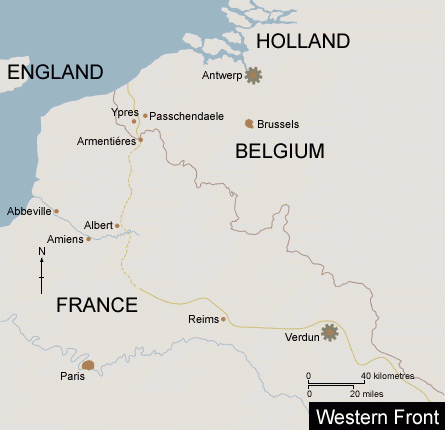Captured in colour: rare photographs from the First World War - Hurley and Wilkins at the Western Front
In the opening months of the First World War, the German army overran large areas of Belgium and France. Their advance was stopped by British and French forces, and by the end of 1914 a stalemate had developed, with the opposing sides occupying lines of trenches running from the North Sea to the Swiss border.
When Wilkins and Hurley arrived in mid-1917, the front had barely moved in three years, despite millions of deaths in repeatedly unsuccessful offensives. They worked in Flanders throughout the third battle of Ypres, taking images of men surrounded by the machinery of war and engulfed by the battered landscape over which they fought. Noting that they had narrowly avoided death on many occasions, Bean wrote that “neither of them could ever come out of another time like they had at Ypres”.
As with press reports, photographs of the war were subject to strict censorship. No distinction was made between news photographs and those for the historical record; all had to be passed by the censor, whose office was at Warlencourt, near Pozières. Wilkins and Hurley resented this: Hurley once tried to smuggle colour plates out of France, much to Bean’s annoyance. Nevertheless, both made weekly trips to Warlencourt, often visiting Pozières, scene of horrific Australian losses the previous year. There they photographed the abandoned battlefield, finding respite from the war amid reminders of its destructive power.
We had an awesome view over the battlefield to the German lines. What an awful scene of desolation! Everything has been swept away… Everywhere the ground is littered with bits of guns, bayonets, shells and men.
Frank Hurley Diary, 23 August 1917

Map of the western front
Hubert Wilkins
Premier Georges Clemenceau at 4th Australian Division Headquarters, Bussy, 7 July 1918
print from Paget plate
P03631.212
On 4 July 1918 Australian and US troops, under General Sir John Monash, attacked the Germans at Hamel. The battle, though limited in scope, was the most successful undertaken by the allies since repulsing the German March offensive.
In recognition of this feat, French Premier Georges Clemenceau visited the 4th Australian Division’s headquarters at Bussy-les-Daoures, near Corbie. Speaking to the assembled officers, he praised the Australians highly:
I shall go back tomorrow and say to my countrymen: “I have seen the Australians. I have looked in their faces. I know that these men … will fight alongside of us again until the cause for which we are all fighting is safe for us and for our children.”
Wilkins went into the attack at Hamel to photograph Americans in action, but returned to headquarters in time to photograph Clemenceau’s visit.
